
Knots
Simple knot. Note: the loop of a knot is called the "bright." The "standing part" of the rope is the…

Knots
Figure eight knot. Note: the loop of a knot is called the "bright." The "standing part" of the rope…

Knots
Common sheet bend connects two ropes. Note: the loop of a knot is called the "bright." The "standing…

Knots
Common bowline. Note: the loop of a knot is called the "bright." The "standing part" of the rope is…

Knots
Reef knot or square knot. Note: the loop of a knot is called the "bright." The "standing part" of the…

Knots
Carrick bend joins two ropes. Note: the loop of a knot is called the bright. The standing part of the…

Knots
Flemish loop. Note: the loop of a knot is called the "bright." The "standing part" of the rope is the…

Knots
Chain knot and toggle. The toggle is pulled to tighten up all the loops. Note: the loop of a knot is…

Knots
Sheepshank. Note: the loop of a knot is called the "bright." The "standing part" of the rope is the…
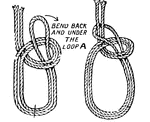
Knots
Bowline on a bight show in two stages. Note: the loop of a knot is called the "bright." The "standing…
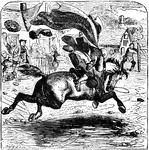
John Gilpin
Gilpin on his horse. "The wind did blow, the cloak did fly, Like streamer long and gray. Till, loop…

Union Pacific
"The big loop on the Georgetown branch of the Union Pacific, Colorado."—E. Benjamin Andrews 1895
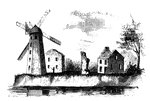
Wind-Mill Point
Wind-mill Point. This view was sketched from the steam-boat, when a little below the wind-mill, looking…
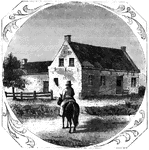
Vankleek House
The Vankleek House. It was built by Myndert Vankleek, one of the first settlers in Dutchess county,…

Knots and Splices
"Knots and splices include all the various methods of tying, fastening, and joining ropes or cords.…
Knots and Splices
"Knots and splices include all the various methods of tying, fastening, and joining ropes or cords.…
Knots and Splices
"Knots and splices include all the various methods of tying, fastening, and joining ropes or cords.…
Knots and Splices
"Knots and splices include all the various methods of tying, fastening, and joining ropes or cords.…

Knots and Splices
"Knots and splices include all the various methods of tying, fastening, and joining ropes or cords.…

Knots and Splices
"Knots and splices include all the various methods of tying, fastening, and joining ropes or cords.…
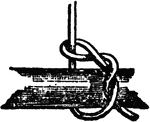
Knots and Splices
"Knots and splices include all the various methods of tying, fastening, and joining ropes or cords.…
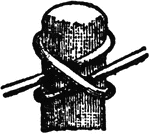
Knots and Splices
"Knots and splices include all the various methods of tying, fastening, and joining ropes or cords.…

Knots and Splices
"Knots and splices include all the various methods of tying, fastening, and joining ropes or cords.…
Knots and Splices
"Knots and splices include all the various methods of tying, fastening, and joining ropes or cords.…
Knots and Splices
"Knots and splices include all the various methods of tying, fastening, and joining ropes or cords.…
Knots and Splices
"Knots and splices include all the various methods of tying, fastening, and joining ropes or cords.…

Knots and Splices
"Knots and splices include all the various methods of tying, fastening, and joining ropes or cords.…
Knots and Splices
"Knots and splices include all the various methods of tying, fastening, and joining ropes or cords.…
Knots and Splices
"Knots and splices include all the various methods of tying, fastening, and joining ropes or cords.…

Knots and Splices
"Knots and splices include all the various methods of tying, fastening, and joining ropes or cords.…

Knots and Splices
"Knots and splices include all the various methods of tying, fastening, and joining ropes or cords.…

Knots and Splices
"Knots and splices include all the various methods of tying, fastening, and joining ropes or cords.…

Knots and Splices
"Knots and splices include all the various methods of tying, fastening, and joining ropes or cords.…

Knots and Splices
"Knots and splices include all the various methods of tying, fastening, and joining ropes or cords.…
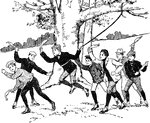
Sling the Monkey
"Sling the Monkey is a capital game, and can be played anywhere where there are trees. One player who…

Ring the Bull
"This amusing game requires more care and delicacy of touch than at first seems to be the case. The…
Dummy
"Good judgement of distance is essential. Accuracy in thrusting and lunging is best attained by practicing…
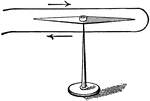
Needle, compass
"Bring the two ends of the wire into contact, and thus close the circuit. The needle instantly flies…

Cravat bow
"Plait the ribbon a distance from the end to allow for a streamer or bow end. Hold the plaits with the…
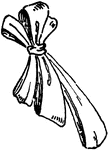
Uneven bow
"For the uneven bow, measure a long loop, plait, and hold with right hand. Opposite this, measure, plait,…
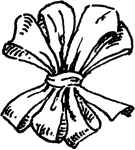
Rosette of even loops
"Measure all loops so they are of even lengths. Have the same number of loops on each side of the knot.…

Pear Design
"Also known as the cone, the palm leaf, the river loop, the crown jewel, the seal, the almond, the feather,…
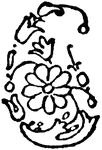
Pear Design
"Also known as the cone, the palm leaf, the river loop, the crown jewel, the seal, the almond, the feather,…

Pear Design
"Also known as the cone, the palm leaf, the river loop, the crown jewel, the seal, the almond, the feather,…

Pear Design
"Also known as the cone, the palm leaf, the river loop, the crown jewel, the seal, the almond, the feather,…
Pear Design
"Also known as the cone, the palm leaf, the river loop, the crown jewel, the seal, the almond, the feather,…
Pear Design
"Also known as the cone, the palm leaf, the river loop, the crown jewel, the seal, the almond, the feather,…
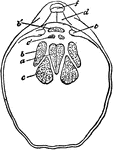
Dorsal Valve
"Waldheimia flavescens. Interior of dorsal valve. c, c', cardial process; b', hinge-plate; s, dental…

Valves
"Longitudinal section of valves. A, ventral, B, dorsal valves; l, loop; q, crura; ss, septum; c, cardinal…
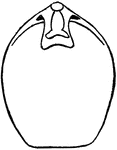
Dorsal Valve
"Terebratula virea. Interior of dorsal valve. l, loop; b, hinge-plate; c, cardinal process." —…

Muscular System
"Diagram showing the muscular system. M, ventral, N, dorsal valve; l, loop; V, mouth; Z, extremity of…

Intestinal Tract of Macropus Bennetti
S, cut end of duodenum; R, cut end of rectum; C, caecum; C2, accessory caecum; C.L., colic loop of hind-gut.
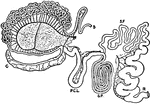
Intestinal Tract of Giraffe
S, cut end of duodenum; R, cut end of rectum; C, caecum; P.C.L., post-caecal loop; S.P., spiral loop;…

Hosiery
"In the year 1589 the stocking-frame, the machine which mechanically produces the looped stitch in hosiery,…

Tumbler Needle
"An improvement of great importance in the hosiery trade was effected through the invention of the tumbler…
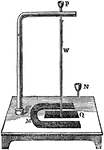
Wire Vibration
"Vibration of a wire. A conducting copper wire, w, is suspended by a loop from a hook of the same metal,…

Brachiopoda
Magellania flavescens. Longitudinal section of valves. A, ventral; B, dorsal valves; l, loop; q, crura;…


